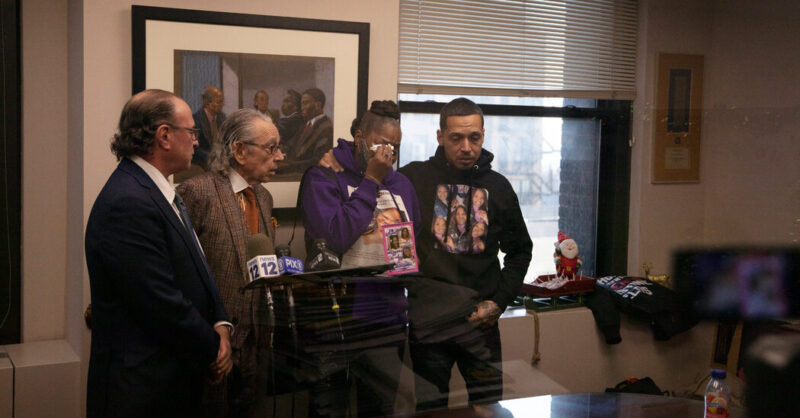Why New York Has Faltered in Making Childbirth Safer for Black Mothers

Late last year, a 30-year-old woman, Christine Fields, died after giving birth at a public hospital in Brooklyn. Within a few weeks, inspectors from the New York State Department of Health arrived and began pulling medical files and interviewing doctors and nurses, the agency said.
This was not the first time government authorities had investigated the labor and delivery department at the hospital, Woodhull Medical Center. In 2020, inspectors determined that a botched epidural, one in a series by the same Woodhull anesthesiologist, had led to the death of a 26-year-old first-time mother named Sha-Asia Semple.
Both Ms. Fields and Ms. Semple were Black. Their deaths have made Woodhull a symbol of one of the most striking racial disparities in New York: Black women are nine times more likely to die from pregnancy or childbirth than white women in New York City, a far starker disparity than the national one.
New York’s disturbing record on maternal health has received growing attention from lawmakers, health authorities, activists and even filmmakers. In recent years, there has been a flurry of new legislation and programs: more government funding for doulas; a state board examining every maternal death; surveys for new mothers about their childbirth experience, with questions about racism.
On Thursday, Gov. Kathy Hochul proposed her own six-point plan to address the problem, which includes paid prenatal leave, no co-pays for prenatal visits and a monitoring system for unnecessary cesarean sections.
But it remains to be seen whether the attention or interventions will have much effect. In fact, by some indicators maternal health in New York is worsening.
A spokeswoman for the State Health Department, Danielle De Souza, said the agency could not comment on the specifics of what may have happened at Woodhull, because it is an open investigation.
“While we cannot comment on individual cases, the department has strong policies in place with an objective to keep parents and babies healthy, safe and protected from any potential instances of misconduct,” Ms. De Souza said in a statement.
Dr. Wendy Wilcox, the chief women’s health officer for the city’s public hospital system, said that she did not have any specific concerns about Woodhull. “While we strive for improvement in quality and safety, we certainly think our hospitals are safe places to birth babies,” Dr. Wilcox said.
There were 29 maternal deaths related to pregnancy and childbirth in 2020, according to the most recent citywide data available from the New York City Department of Health and Mental Hygiene. Of the women who died, 12 were Black, nine were Latina, four were Asian and four were white.
The reasons for the racial disparities are complex and varied, experts say. In New York City, chronic conditions like diabetes and hypertension, which can make pregnancy riskier, are more prevalent in Black and Hispanic residents than white residents.
The coronavirus pandemic has also left many people in worse health overall, including pregnant women, and contributed to a growing staffing deficit among doctors and nurses. On some labor and delivery floors in poorer neighborhoods, understaffing has led to deteriorating safety conditions, and may have played a role in infant deaths or severe injuries, according to interviews with doctors and nurses. Black mothers also often face racism, in the form of unconscious bias, denied medication or verbal abuse, that can make childbirth deadlier, research has found.
Nationwide the number of maternal deaths soared in 2020 and 2021, as Covid-19 contributed to dangerous health conditions for pregnant women. In New York State, maternal mortality rates actually dropped in 2020, but rose significantly in 2021, according to the Centers for Disease Control and Prevention.
Doctors cite growing problems that are interacting with each other in worrisome ways in the wake of the pandemic. Conditions like unmanaged hypertension and anemia can increase the likelihood of a C-section or the risk of postpartum hemorrhage. And staffing shortages and high rates of turnover among doctors have left some labor floors less adept at responding to such emergencies.
The staff shortages have also been felt in clinics where many pregnant women on Medicaid or with no insurance go for prenatal care. Such care, the centerpiece of the governor’s new initiative, lowers the risk for a range of pregnancy complications.
But in the Bronx, under 60 percent of pregnant women receive prenatal care in their first trimester, the city’s lowest rate. The percentage of Bronx women receiving what is regarded as adequate prenatal care, or better, over the course of a pregnancy has dropped slightly in recent years, a trend also seen in Brooklyn.
In some cases, the reason is not that women don’t seek out care, but that there are few appointments to be had.
At the Montefiore Medical Center, a private hospital system and the Bronx’s largest health care provider, 20 percent of current pregnant patients had no follow-up appointment scheduled, according to a PowerPoint slide obtained by The New York Times. The number of phone calls the hospital has received from those seeking prenatal care has dwarfed the number of available appointments, doctors said in interviews.
Most patients giving birth at Montefiore in the Bronx are Hispanic or Black. The vast majority have Medicaid. The Bronx has the highest poverty rate of any borough in the city.
In August 2022, a recent immigrant from Jamaica who is Black showed up at Montefiore’s Wakefield campus in the Bronx. The woman, 28, was in her third trimester and hoping to become a Montefiore patient. She and her baby were deemed stable, though she had high blood pressure.
For her next prenatal appointment, she was told to call a Montefiore clinic. But when she did, she learned that the first availability wasn’t until November — two months past her September due date, recalled the woman, who asked that she be identified only by her first name, Razanaha, in an interview.
She had no further prenatal appointments. A few nights before her due date, she felt the baby moving less. When she arrived at the hospital, Razanaha recalled being told that it was “a very busy day.” A quick fetal heart rate check appeared normal enough, according to a four-page summary of the case by Montefiore’s Quality Management Department obtained by The Times. A nurse told Razanaha to count how many kicks she felt. Then the nurse went to care for another patient.
There were no kicks to count. But it was a while before anyone checked on her again. Razanaha was not put on a continuous fetal heart rate monitor, a standard step for mothers reporting decreased movement, until nearly 90 minutes after first arriving, according to the case review.
“When they hooked me up, they finally realized he’s dying,” Razanaha recalled. An emergency C-section quickly followed.
“He emerged with no cry,” the case review states.
During an internal meeting afterward, doctors were urged to consider whether there had been “an opportunity to place this patient on the fetal monitor earlier” and whether staffing levels had affected the outcome, according to the “discussion points” listed on the case review.
At the time, so many specialists in high-risk pregnancies were leaving Montefiore that the hospital was having difficulty staffing its two main labor and delivery floors in the Bronx, which include Wakefield, one Montefiore doctor said in a recording of a departmental meeting in January 2023 obtained by The Times.
“We do not have adequate number of faculty to safely staff two separate inpatient maternity O.B. services,” the doctor said in the recording.
On the recording, the doctor is also heard blaming the “significant increase” in severe complications on physician “burnout” as doctors were assigned an increasing number of overnight shifts.
At Montefiore, about 10 percent of deliveries on its main labor and delivery floor in 2022 involved a potentially life-threatening complication, according to an internal hospital document. That is a startling 66 percent increase from before the pandemic, when the rate of serious complications was close to 6 percent — which was already twice the citywide average.
In 2022, an Ecuadorean immigrant who had pre-eclampsia, a dangerous pregnancy condition, died at a Montefiore hospital in the Bronx, following a stroke, according to her sister, Gabriela Huaraca. Ms. Huaraca is now raising her sister’s baby, who was delivered by emergency C-section.
Dr. Andrew Racine, Montefiore’s chief medical officer, noted that the women who delivered at Montefiore tended to have higher rates of underlying risk factors, such as obesity and diabetes, than pregnant women elsewhere in the city.
Even so, the maternal mortality rate linked to Montefiore was well below the Bronx-wide rate, and was even below the citywide rate for many years, Dr. Racine said.
“If you’re looking to have a safe delivery, this is the place to come,” he said in an interview last year.
In September 2022, Mayor Eric Adams signed seven bills aimed at solving the city’s maternal mortality problem. The new laws promised more education and more doulas.
The bills were promoted as a turning point: the first city legislation to address disparities in maternal mortality, and, as Council Speaker Adrienne E. Adams put it, “a significant step in our city’s efforts to begin addressing this long overdue issue.”
But at Woodhull, the deaths of Ms. Semple and Ms. Fields put a spotlight on another contributor to racial disparities in childbirth that will be harder to address: hospital quality.
One 2016 study estimated that the differing performance of hospitals could account for nearly half of the racial disparity in severe maternal morbidity rates.
In New York, white women are more likely than Black women to deliver at top-notch academic medical centers. Black women are more likely to deliver at public hospitals or struggling private “safety-net” hospitals, where understaffing is more of a problem and the safety records tend to be lower.
It is still unclear what went wrong after Ms. Fields, a 30-year-old mother of two, arrived at Woodhull Medical Center on a Sunday in November, and whether her death could have been prevented by staff members there, or if there might have been a different outcome if she had delivered elsewhere.
She told employees there that she did not want a C-section, family members said. When her baby’s heart rate began to drop, doctors insisted on it, her fiancé, Jose Perez, recalled in an interview outside the hospital later that week.
After their son was delivered, Ms. Fields said she was feeling “strange,” Mr. Perez recalled. Hospital employees were soon performing CPR on her, Mr. Perez said. The medical examiner listed her cause of death as hemorrhage following a C-section.
Standing outside Woodhull four days later, Mr. Perez said that he had yet to tell their two older children, ages 5 and 2, what had happened. “They expect Mom to come home,” he said, tears streaking his face.
Kirsten Noyes and Liset Cruz contributed reporting.
Audio produced by Patricia Sulbarán.








